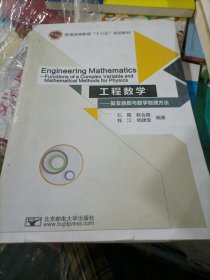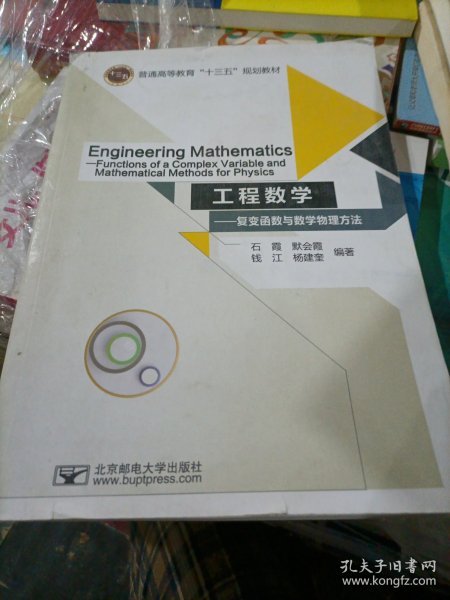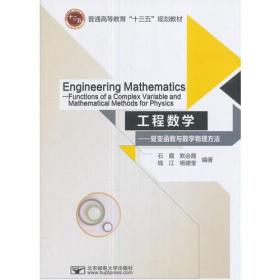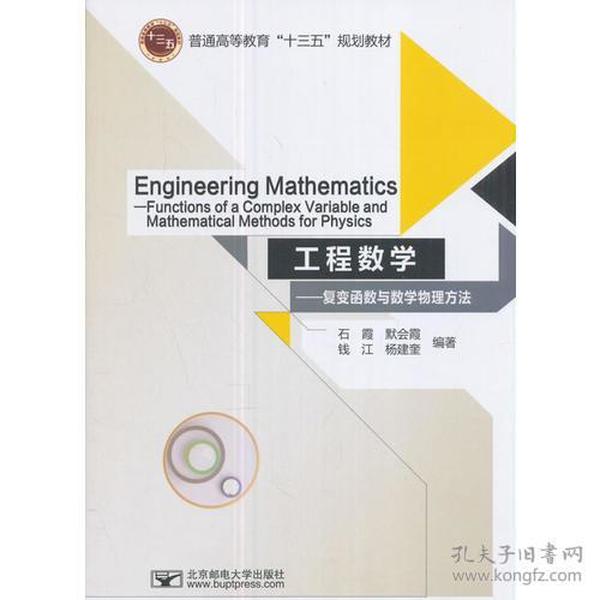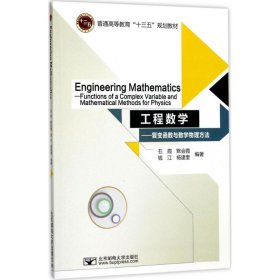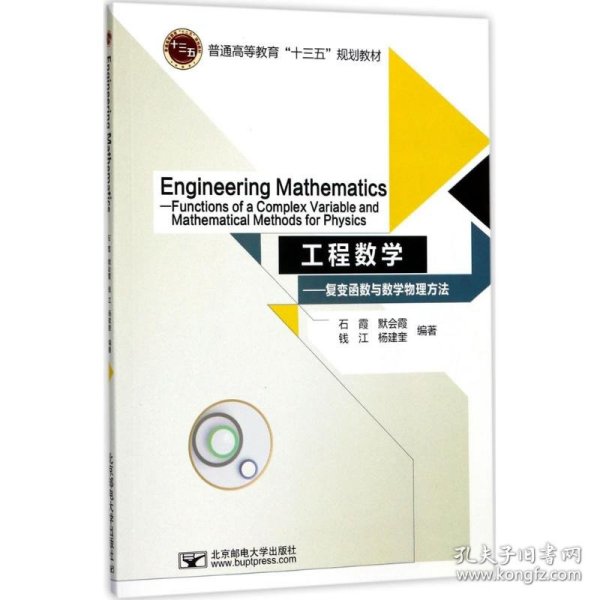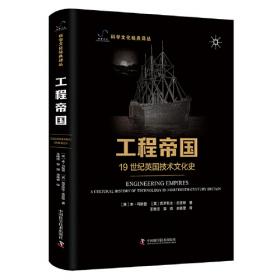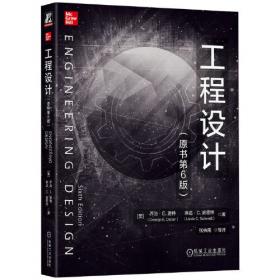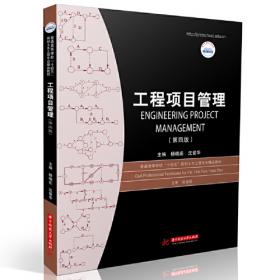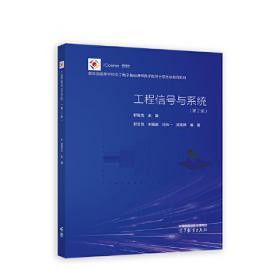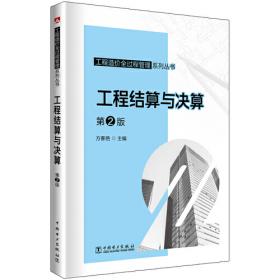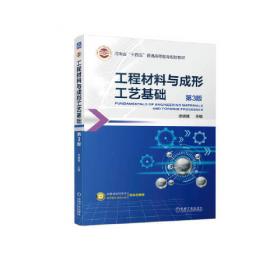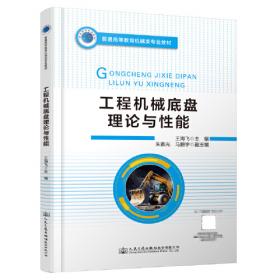工程数学——复变函数与数学物理方法
出版时间:
2017-10
版次:
1
ISBN:
9787563552641
定价:
35.00
装帧:
其他
开本:
16开
纸张:
胶版纸
23人买过
-
本教材是一本用于同名课程双语教学的英文教材,编者按照国家教育部对本课程的基本要求,参考了多本有关的英文教材,结合多年的教学实践编著而成。本教材包含复变函数和数学物理方法两部分。复变函数部分的内容包括:复数与复变函数的基本概念、复变函数的导数和积分、解析函数的定义和性质、解析函数的幂级数表示、留数定理及其应用等。数学物理方法部分的内容包括:三类典型方程的导出和定解问题的定义、二阶线性偏微分方程的分类和化简以及达朗贝尔公式求解波动方程、分离变量法求解定解问题和特征值问题、贝塞尔函数和勒让德多项式、傅里叶变换和拉普拉斯变换。
本教材可作为理工科院校非数学专业本科生的双语教材,也可供有关工程技术人员参考。
This book contributes to the bilingual teaching of engineering mathematics.The selection of the contents is in accordance with the fundamental requirements for this course and based on years of practice in the course of the authors. The contents of this book include two main parts, that is, complex variables and mathematical methods for physics. Complex variables part includes the basic concepts of the complex number and complex function, the derivative and integral of the complex function, the definition and properties of the analytic function, the power series expansion of the analytic function, the residue theorem and its application. Mathematical methods for physics part includes the three typical equations and the definition of the well-posed problem, the classification and simplification of the second order linear partial differential equations and theD'Alembert formula for string oscillation, the method of separation of variables for the well-posed problems and the eigenvalue problem, Bessel function and Legendre polynomial, Fourier integral transformation and Laplace integral transformation.
This book can be used as the bilingual textbook for undergraduate students in the science and technological schools whose majors are not mathematics, and may also be suitable to the related engineers and technicians. ngineering Mathematics—Functions of a Complex Variable and Mathematical Methods for Physics
Contents
Contents
Part Ⅰ Functions of a Complex Variable
Chapter 1 Complex Numbers and Complex Functions3
1.1 Complex number and its operations3
1.1.1 Complex number and its expression3
1.1.2 The operations of complex numbers6
1.1.3 Regions in the complex plane13
Exercises 1.114
1.2 Functions of a complex variable15
1.2.1 Definition of function of a complex variable15
1.2.2 Complex mappings17
Exercises 1.220
1.3 Limit and continuity of a complex function21
1.3.1 Limit of a complex function21
1.3.2 Continuity of a complex function26
Exercises 1.327
Chapter 2 Analytic Functions29
2.1 Derivatives of complex functions29
2.1.1 Derivatives29
2.1.2 Some properties of derivatives31
2.1.3 A necessary condition on differentiability31
2.1.4 Sufficient conditions on differentiability34
Exercises 2.136
2.2 Analytic functions37
2.2.1 Analytic functions37
2.2.2 Harmonic functions39
Exercises 2.241
2.3 Elementary functions41
2.3.1 Exponential functions41
2.3.2 Logarithmic functions42
2.3.3 Complex exponents45
2.3.4 Trigonometric functions46
2.3.5 Hyperbolic functions48
2.3.6 Inverse trigonometric and hyperbolic functions49
Exercises 2.350
Chapter 3 Integral of Complex Function52
3.1 Derivatives and definite integrals of functions w(t)52
3.1.1 Derivatives of functions w(t)52
3.1.2 Definite integrals of functions w(t)53
Exercises 3.156
3.2 Contour integral56
3.2.1 Contour56
3.2.2 Definition of contour integral58
3.2.3 Antiderivatives66
Exercises 3.273
3.3 Cauchy integral theorem75
3.3.1 Cauchy?Goursat theorem 75
3.3.2 Simply and multiply connected domains76
Exercises 3.380
3.4 Cauchy integral formula and derivatives of analytic functions81
3.4.1 Cauchy integral formula81
3.4.2 Higher?order derivatives formula of analytic functions84
Exercises 3.487
Chapter 4 Complex Series89
4.1 Complex series and its convergence89
4.1.1 Complex sequences and its convergence89
4.1.2 Complex series and its convergence90
Exercises 4.193
4.2 Power series93
4.2.1 The definition of power series93
4.2.2 The convergence of power series95
4.2.3 The operations of power series97
Exercises 4.297
4.3 Taylor series98
4.3.1 Taylor's theorem98
4.3.2 Taylor expansions of analytic functions100
Exercises 4.3104
4.4 Laurent series105
4.4.1 Laurent's theorem105
4.4.2 Laurent series expansion of analytic functions109
Exercises 4.4111
Chapter 5 Residues and Its Application113
5.1 Three types of isolated singular points113
Exercises 5.1118
5.2 Residues and Cauchy's residue theorem118
Exercises 5.2123
5.3 Application of residues on definite integrals123
5.3.1 Improper integrals124
5.3.2 Improper integrals involving sines and cosines125
5.3.3 Integrals on [0,2π] involving sines and cosines128
Exercises 5.3130
Part Ⅱ Mathematical Methods for Physics
Chapter 6 Equations of Mathematical Physics and
Problems for Defining Solutions135
6.1 Basic concept and definition135
6.1.1 Basic concept 136
6.1.2 Linear operator and linear composition138
6.1.3 Calculation rule of operator140
6.2 Three typical partial differential equations and problems for defining solutions141
6.2.1 Wave equations and physical derivations141
6.2.2 Heat (conduction) equations and physical derivations143
6.2.3 Laplace equations and physical derivations144
6.3 Well?posed problem145
6.3.1 Initial conditions146
6.3.2 Boundary conditions146
Chapter 7 Classification and Simplification for Linear Second Order PDEs148
7.1 Classification of linear second order partial differential equations with two
variables148
Exercises 7.1149
7.2 Simplification to standard forms149
Exercises 7.2156
Chapter 8 Integral Method on Characteristics158
8.1 D'Alembert formula for one dimensional infinite string oscillation158
Exercises 8.1160
8.2 Small oscillations of semi?infinite string with rigidly fixed or free ends, method
of prolongation160
Exercises 8.2162
8.3 Integral method on characteristics for other second order PDEs, some examples162
Exercises 8.3165
Chapter 9 The Method of Separation of Variables on Finite Region166
9.1 Separation of variables for (1 1)?dimensional homogeneous equations167
9.1.1 Separation of variables for wave equation on finite region167
9.1.2 Separation of variables for heat equation on finite region170
Exercises 9.1 172
9.2 Separation of variables for 2?dimensional Laplace equations174
9.2.1 Laplace equation with rectangular boundary174
9.2.2 Laplace equation with circular boundary177
Exercises 9.2180
9.3 Nonhomogeneous equations and nonhomogeneous boundary conditions181
Exercises 9.3192
9.4 Sturm?Liouville eigenvalue problem192
Exercises 9.4198
Chapter 10 Special Functions199
10.1 Bessel function199
10.1.1 Introduction to the Bessel equation199
10.1.2 The solution of the Bessel equation201
10.1.3 The recurrence formula of the Bessel function204
10.1.4 The properties of the Bessel function207
10.1.5 Application of Bessel function210
Exercises 10.1213
10.2 Legendre polynomial214
10.2.1 Introduction of the Legendre equation214
10.2.2 The solution of the Legendre equation216
10.2.3 The properties of the Legendre polynomial and recurrence formula218
10.2.4 Application of Legendre polynomial 221
Exercises 10.2223
Chapter 11 Integral Transformations224
11.1 Fourier integral transformation224
11.1.1 Definition of Fourier integral transformation225
11.1.2 The properties of Fourier integral transformation228
11.1.3 Convolution and its Fourier transformation230
11.1.4 Application of Fourier integral transformation231
Exercises 11.1235
11.2 Laplace integral transformation236
11.2.1 Definition of Laplace transformation236
11.2.2 Properties of Laplace transformation238
11.2.3 Convolution and its Laplace transformation241
11.2.4 Application of Laplace integral transformation242
Exercises 11.2244
References245
-
内容简介:
本教材是一本用于同名课程双语教学的英文教材,编者按照国家教育部对本课程的基本要求,参考了多本有关的英文教材,结合多年的教学实践编著而成。本教材包含复变函数和数学物理方法两部分。复变函数部分的内容包括:复数与复变函数的基本概念、复变函数的导数和积分、解析函数的定义和性质、解析函数的幂级数表示、留数定理及其应用等。数学物理方法部分的内容包括:三类典型方程的导出和定解问题的定义、二阶线性偏微分方程的分类和化简以及达朗贝尔公式求解波动方程、分离变量法求解定解问题和特征值问题、贝塞尔函数和勒让德多项式、傅里叶变换和拉普拉斯变换。
本教材可作为理工科院校非数学专业本科生的双语教材,也可供有关工程技术人员参考。
This book contributes to the bilingual teaching of engineering mathematics.The selection of the contents is in accordance with the fundamental requirements for this course and based on years of practice in the course of the authors. The contents of this book include two main parts, that is, complex variables and mathematical methods for physics. Complex variables part includes the basic concepts of the complex number and complex function, the derivative and integral of the complex function, the definition and properties of the analytic function, the power series expansion of the analytic function, the residue theorem and its application. Mathematical methods for physics part includes the three typical equations and the definition of the well-posed problem, the classification and simplification of the second order linear partial differential equations and theD'Alembert formula for string oscillation, the method of separation of variables for the well-posed problems and the eigenvalue problem, Bessel function and Legendre polynomial, Fourier integral transformation and Laplace integral transformation.
This book can be used as the bilingual textbook for undergraduate students in the science and technological schools whose majors are not mathematics, and may also be suitable to the related engineers and technicians.
-
目录:
ngineering Mathematics—Functions of a Complex Variable and Mathematical Methods for Physics
Contents
Contents
Part Ⅰ Functions of a Complex Variable
Chapter 1 Complex Numbers and Complex Functions3
1.1 Complex number and its operations3
1.1.1 Complex number and its expression3
1.1.2 The operations of complex numbers6
1.1.3 Regions in the complex plane13
Exercises 1.114
1.2 Functions of a complex variable15
1.2.1 Definition of function of a complex variable15
1.2.2 Complex mappings17
Exercises 1.220
1.3 Limit and continuity of a complex function21
1.3.1 Limit of a complex function21
1.3.2 Continuity of a complex function26
Exercises 1.327
Chapter 2 Analytic Functions29
2.1 Derivatives of complex functions29
2.1.1 Derivatives29
2.1.2 Some properties of derivatives31
2.1.3 A necessary condition on differentiability31
2.1.4 Sufficient conditions on differentiability34
Exercises 2.136
2.2 Analytic functions37
2.2.1 Analytic functions37
2.2.2 Harmonic functions39
Exercises 2.241
2.3 Elementary functions41
2.3.1 Exponential functions41
2.3.2 Logarithmic functions42
2.3.3 Complex exponents45
2.3.4 Trigonometric functions46
2.3.5 Hyperbolic functions48
2.3.6 Inverse trigonometric and hyperbolic functions49
Exercises 2.350
Chapter 3 Integral of Complex Function52
3.1 Derivatives and definite integrals of functions w(t)52
3.1.1 Derivatives of functions w(t)52
3.1.2 Definite integrals of functions w(t)53
Exercises 3.156
3.2 Contour integral56
3.2.1 Contour56
3.2.2 Definition of contour integral58
3.2.3 Antiderivatives66
Exercises 3.273
3.3 Cauchy integral theorem75
3.3.1 Cauchy?Goursat theorem 75
3.3.2 Simply and multiply connected domains76
Exercises 3.380
3.4 Cauchy integral formula and derivatives of analytic functions81
3.4.1 Cauchy integral formula81
3.4.2 Higher?order derivatives formula of analytic functions84
Exercises 3.487
Chapter 4 Complex Series89
4.1 Complex series and its convergence89
4.1.1 Complex sequences and its convergence89
4.1.2 Complex series and its convergence90
Exercises 4.193
4.2 Power series93
4.2.1 The definition of power series93
4.2.2 The convergence of power series95
4.2.3 The operations of power series97
Exercises 4.297
4.3 Taylor series98
4.3.1 Taylor's theorem98
4.3.2 Taylor expansions of analytic functions100
Exercises 4.3104
4.4 Laurent series105
4.4.1 Laurent's theorem105
4.4.2 Laurent series expansion of analytic functions109
Exercises 4.4111
Chapter 5 Residues and Its Application113
5.1 Three types of isolated singular points113
Exercises 5.1118
5.2 Residues and Cauchy's residue theorem118
Exercises 5.2123
5.3 Application of residues on definite integrals123
5.3.1 Improper integrals124
5.3.2 Improper integrals involving sines and cosines125
5.3.3 Integrals on [0,2π] involving sines and cosines128
Exercises 5.3130
Part Ⅱ Mathematical Methods for Physics
Chapter 6 Equations of Mathematical Physics and
Problems for Defining Solutions135
6.1 Basic concept and definition135
6.1.1 Basic concept 136
6.1.2 Linear operator and linear composition138
6.1.3 Calculation rule of operator140
6.2 Three typical partial differential equations and problems for defining solutions141
6.2.1 Wave equations and physical derivations141
6.2.2 Heat (conduction) equations and physical derivations143
6.2.3 Laplace equations and physical derivations144
6.3 Well?posed problem145
6.3.1 Initial conditions146
6.3.2 Boundary conditions146
Chapter 7 Classification and Simplification for Linear Second Order PDEs148
7.1 Classification of linear second order partial differential equations with two
variables148
Exercises 7.1149
7.2 Simplification to standard forms149
Exercises 7.2156
Chapter 8 Integral Method on Characteristics158
8.1 D'Alembert formula for one dimensional infinite string oscillation158
Exercises 8.1160
8.2 Small oscillations of semi?infinite string with rigidly fixed or free ends, method
of prolongation160
Exercises 8.2162
8.3 Integral method on characteristics for other second order PDEs, some examples162
Exercises 8.3165
Chapter 9 The Method of Separation of Variables on Finite Region166
9.1 Separation of variables for (1 1)?dimensional homogeneous equations167
9.1.1 Separation of variables for wave equation on finite region167
9.1.2 Separation of variables for heat equation on finite region170
Exercises 9.1 172
9.2 Separation of variables for 2?dimensional Laplace equations174
9.2.1 Laplace equation with rectangular boundary174
9.2.2 Laplace equation with circular boundary177
Exercises 9.2180
9.3 Nonhomogeneous equations and nonhomogeneous boundary conditions181
Exercises 9.3192
9.4 Sturm?Liouville eigenvalue problem192
Exercises 9.4198
Chapter 10 Special Functions199
10.1 Bessel function199
10.1.1 Introduction to the Bessel equation199
10.1.2 The solution of the Bessel equation201
10.1.3 The recurrence formula of the Bessel function204
10.1.4 The properties of the Bessel function207
10.1.5 Application of Bessel function210
Exercises 10.1213
10.2 Legendre polynomial214
10.2.1 Introduction of the Legendre equation214
10.2.2 The solution of the Legendre equation216
10.2.3 The properties of the Legendre polynomial and recurrence formula218
10.2.4 Application of Legendre polynomial 221
Exercises 10.2223
Chapter 11 Integral Transformations224
11.1 Fourier integral transformation224
11.1.1 Definition of Fourier integral transformation225
11.1.2 The properties of Fourier integral transformation228
11.1.3 Convolution and its Fourier transformation230
11.1.4 Application of Fourier integral transformation231
Exercises 11.1235
11.2 Laplace integral transformation236
11.2.1 Definition of Laplace transformation236
11.2.2 Properties of Laplace transformation238
11.2.3 Convolution and its Laplace transformation241
11.2.4 Application of Laplace integral transformation242
Exercises 11.2244
References245
查看详情
-
全新
北京市丰台区
平均发货14小时
成功完成率87.25%
-
全新
河北省保定市
平均发货11小时
成功完成率92.88%
-
全新
北京市房山区
平均发货26小时
成功完成率85.21%
-
全新
河北省保定市
平均发货28小时
成功完成率91.36%
-
全新
河北省保定市
平均发货17小时
成功完成率88.08%
-
全新
河北省保定市
平均发货10小时
成功完成率82.75%

 占位居中
占位居中

